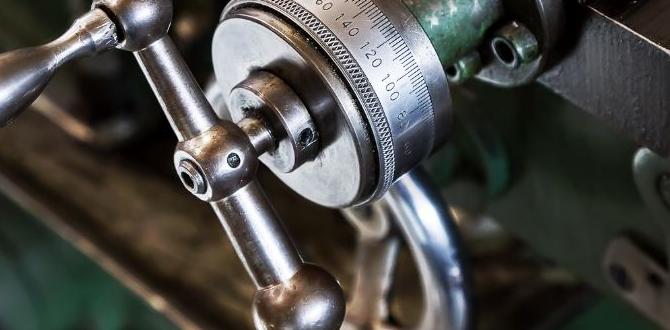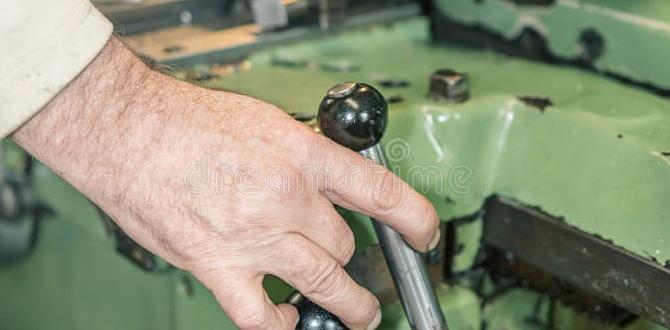For easy and clean copper milling, a 1/8 inch solid carbide end mill with a 1/2 inch shank and standard length is your go-to. Its specialized geometry ensures excellent chip evacuation, preventing tool clogging and overheating for smooth, precise cuts.
Working with copper on a milling machine can be tricky. It’s a soft metal, which sounds great, but it can also be gummy. This means your tools can clog up quickly, leading to rough cuts or even broken bits. Finding the right cutting tool makes all the difference. That’s where a specific type of end mill comes in: the 1/8 inch solid carbide end mill designed for copper. If you’re struggling with sticky chips and frustrating milling sessions, you’re in the right place. We’ll walk through exactly why this tool is so effective and how to use it to get beautiful results, every time.
Why a 1/8 Inch Carbide End Mill is Perfect for Copper
Copper is a fantastic material for many projects, from decorative pieces to functional components. However, its malleability presents unique machining challenges. Soft metals like copper can easily deform and stick to cutting tool edges, leading to what machinists often call “built-up edge” (BUE). This BUE reduces cutting efficiency, damages the surface finish of the workpiece, and can even cause the tool to break.
Traditional end mills might struggle. They can be too aggressive, leading to chip welding, or not designed to handle the specific way copper chips form. This is where specialized tooling shines. A 1/8 inch solid carbide end mill, particularly one engineered for softer metals like copper, brings several key advantages to your milling setup.
The Advantages of Carbide
Carbide (specifically, tungsten carbide) is a super-hard material that offers superior wear resistance and rigidity compared to high-speed steel (HSS). This means it stays sharper for longer, even when cutting tougher materials. For copper, this hardness allows it to maintain a clean cutting edge, resisting the tendency for copper to stick and buildup.
The Significance of 1/8 Inch Diameter
A 1/8 inch diameter end mill is ideal for detailed work on copper. This size allows for intricate cuts, fine details, and smaller features that are often found in copper projects. It’s versatile enough for engraving, pocketing delicate areas, and creating precise contours without removing excessive material at once. This smaller size also helps manage chip load and heat more effectively in softer metals.
The Role of the 1/2 Inch Shank
The 1/2 inch shank provides excellent rigidity and stability in the milling machine collet or tool holder. A larger shank diameter generally means greater stiffness, which is crucial for achieving accurate and chatter-free cuts. For a 1/8 inch diameter tool, a 1/2 inch shank ensures that the tool doesn’t deflect under cutting forces, leading to cleaner grooves and more precise dimensions. It also means the tool can handle slightly higher feed rates with less risk of vibration.
Standard Length for Versatility
A standard length end mill offers a good balance between rigidity and reach. While longer tools are available for deep cavities, a standard length is generally more robust and less prone to vibration for typical milling operations in copper. This makes it a reliable choice for general-purpose milling tasks.
Key Features of a “Copper-Specific” End Mill
When we talk about an end mill “for copper,” it means the tool’s geometry is optimized to handle the unique properties of this metal. Here are the crucial features to look for:
- High Helix Angle: A higher helix angle (often 45 degrees or more) helps to lift the chips away from the cutting edge quickly. This is vital for preventing chip recutting and BUE in gummy materials like copper.
- Polished Flutes: The flutes (the spiral grooves on the tool) should be highly polished. This smooth surface reduces friction and further aids in chip evacuation. Think of it like this: sticky chips have less surface area to grab onto with polished flutes.
- Bright or Uncoated Finish: For copper, uncoated carbide end mills with a bright, polished finish are often preferred. Coatings can sometimes increase friction or adhesion in soft metals. The natural hardness and smoothness of the polished carbide are usually sufficient.
- Fewer Flutes (Typically 2): For softer, gummy materials, end mills with fewer flutes (usually 2) are often recommended. This provides more “open” space in the flutes for chip evacuation and reduces the tendency for chips to clog.
Choosing Your 1/8 Inch Carbide End Mill
When heading to a tool supplier or browsing online, you’ll want to look for specifications that match these ideal characteristics. Here’s a breakdown of what to search for, especially if you’re looking for that specific “carbide end mill 1/8 inch 1/2 shank standard length for copper chip evacuation”:
Look for product descriptions that mention:
- Material: Solid Carbide
- Diameter: 1/8″ (0.125 inches)
- Shank Diameter: 1/2″ (0.500 inches)
- Number of Flutes: 2 (most common for copper)
- Helix Angle: High (e.g., 45°, 50°, or even 60°)
- Coating: Uncoated or Bright (Polished)
- Intended Use: Non-ferrous metals, Aluminum, Copper, Brass, Plastics.
- Length: Standard or General Purpose (around 1.5 to 2 inches overall length, with a cutting length typically under 1/2 inch).
Here’s an example of how this might look on a product:
| Specification | Details for Copper Milling |
|---|---|
| Material | Solid Tungsten Carbide |
| End Mill Diameter | 1/8″ (0.125″ / 3.175mm) |
| Shank Diameter | 1/2″ (0.500″ / 12.7mm) |
| Number of Flutes | 2 Flutes |
| Helix Angle | High (e.g., 45° or higher) |
| Surface Finish | Bright / Polished / Uncoated |
| Application | Copper, Brass, Aluminum, Plastics (Non-Ferrous) |
| Overall Length | Standard (e.g., 1.5″ – 2.0″) |
| Cutting Length | Short to Medium (e.g., 1/4″ – 3/8″) |
When you see these features combined, you’re looking at a tool specifically designed to tackle the stickiness of copper and provide excellent chip clearance. This makes your milling process smoother, more efficient, and much less frustrating.
Setting Up Your Milling Machine for Copper
Even with the perfect tool, proper machine setup and cutting parameters are essential for successful copper milling. Here’s what beginners need to consider:
1. Secure Your Workpiece Firmly
Copper can be “grabby.” Make sure your workpiece is clamped down securely on your milling machine table. Use appropriate workholding methods like vises, clamps, or even specialized fixtures. Any movement can lead to poor surface finish, inaccurate dimensions, or even tool breakage.
2. Lubrication and Coolant
While some machinists mill copper dry, using a lubricant or coolant can significantly improve results by reducing friction, carrying away heat, and helping to prevent chip welding. For copper, a light, general-purpose cutting fluid or even a specialized aluminum/copper cutting lubricant is ideal.
You can apply it using:
- Mist Coolant System: A fine spray of coolant delivered directly to the cutting zone.
- Flood Coolant System: A constant flow of coolant.
- Manual Application: A brush or squirt bottle can be used for simpler setups, ensuring the lubricant gets to the point of contact.
A good resource for understanding coolants and their applications in machining can be found through organizations like the Society of Manufacturing Engineers (SME), which often publishes guides on machining best practices.
3. Setting Spindle Speed (RPM)
Spindle speed is critical. For copper and a 1/8 inch carbide end mill, you’ll generally want to run at a relatively high spindle speed. This helps to ensure the cutting edges are moving fast enough to shear the material cleanly rather than rubbing and generating excessive heat. A good starting point for a 1/8 inch carbide end mill in copper might be anywhere from 10,000 to 20,000 RPM, depending on your machine’s capabilities and rigidity.
Rule of Thumb: Faster RPMs for softer metals, but always listen to the machine and observe the chips. If you hear rubbing or see gummy, smearing chips, adjust.
4. Setting the Feed Rate
The feed rate is how fast the tool moves into the material. For copper, you want a feed rate that is fast enough to allow the cutting edges to actually cut chips, rather than rub. If the feed is too slow, you’ll still get chip welding. If it’s too fast, you risk overloading the tool or generating excessive heat.
A good starting point for a 1/8 inch 2-flute carbide end mill in copper might be around 10-20 inches per minute (IPM) or 300-500 mm per minute. This will vary based on your depth of cut and machine stiffness.
Chip Load: A related concept is chip load, which is the thickness of the material removed by each cutting edge per revolution (Feed Rate / (RPM * Number of Flutes)). For copper, aim for a moderate chip load, not too thin (which causes rubbing) and not too thick (which can overload the tool).
5. Depth of Cut (DOC) and Stepover
For an end mill this small (1/8 inch), it’s always best to take lighter depths of cut, especially when you’re starting out. For example, if you need to mill a 1/4 inch deep pocket, you might do it in two passes (e.g., 0.125″ DOC per pass) rather than one deep pass. This reduces the load on the tool and improves chip evacuation.
Stepover refers to how much the end mill moves sideways between passes when milling a large area. A good starting stepover for a 1/8 inch end mill might be between 0.040″ and 0.080″. This ensures efficient material removal without excessive tool pressure.
Step-by-Step Milling Process with Your 1/8 Inch Copper End Mill
Let’s put it all together. Here’s a simplified step-by-step guide for milling copper with your new end mill:
- Prepare Your Machine: Ensure your milling machine is clean and the spindle bearings are in good condition.
- Install the End Mill: Securely insert the 1/8 inch carbide end mill into a clean collet and tighten it properly in the spindle. Ensure it’s seated fully.
- Mount Your Workpiece: Firmly clamp your copper workpiece onto the milling machine table. Double-check that it’s square and won’t move during machining.
- Set Up Coolant/Lubricant: If using, ensure your coolant or lubricant system is ready to apply fluid to the cutting zone.
- Program or Set Your Toolpath: Define your milling operations (pocketing, profiling, engraving). Use relatively conservative depths of cut (e.g., 0.06″ to 0.125″) and appropriate stepovers.
- Set Spindle Speed (RPM): Start within the recommended range (e.g., 12,000-18,000 RPM) and be prepared to adjust.
- Set Feed Rate: Start around 15 IPM (approx. 380 mm/min) and observe. Listen to the sound and watch the chips.
- Initiate the Cut: Begin your milling operation. Apply coolant/lubricant liberally to the cutting area.
- Observe and Listen: Pay close attention to the sound of the cut. A smooth, consistent “shaving” sound is good. Grinding, chattering, or high-pitched squeals indicate problems. Watch the chips – they should be small, fluffy, and easily ejected, not long and stringy or welded to the tool.
- Monitor Tool Wear: After each session, inspect the end mill for any signs of wear or chip buildup. If you notice dullness or buildup, clean the flutes and consider adjusting your parameters.
- Make Adjustments as Needed: Based on your observations:
- If you hear chatter or feel vibration: Try reducing the depth of cut, increase the feed rate slightly, or ensure your workpiece and tool are held more rigidly.
- If chips are gummy or welding to the tool: Increase the spindle speed, increase the feed rate to achieve a better chip load, or ensure adequate coolant is being used.
- If the tool seems to be rubbing or making poor surface finish: Ensure you’re not taking too shallow of a depth of cut or a too-slow feed rate.
- Clean Up: Once machining is complete, carefully remove the workpiece and clean your machine and tooling.
Troubleshooting Common Issues
Even with the best tools, you might encounter a few snags. Here’s how to handle them:
- Chip Welding (Built-Up Edge): This is the most common issue with copper. It’s caused by heat and pressure causing the copper to stick to the cutting edge.
- Solution: Increase spindle speed (RPM), increase feed rate to get a better chip load, use more effective coolant/lubrication, or ensure your end mill has polished flutes and a high helix angle.
- Poor Surface Finish: Rough or gummy surfaces.
- Solution: Ensure you have sharp tooling. Check your feed rate and RPM – if they’re too slow, it can cause rubbing. A light finishing pass with a slower feed and higher RPM can sometimes help. Check for tool runout or machine vibration.
- Tool Breakage: End mills breaking, especially smaller ones.
- Solution: Reduce depth of cut, reduce feed rate if it’s too aggressive, ensure the workpiece is held extremely securely, and check that the end mill isn’t excessively worn or damaged. Avoid plunging straight down unless the end mill is specifically designed for it (a “form” or “flat” end mill, not necessarily a spiral for copper).
- Chatter/Vibration: Noisy, uneven cuts.
- Solution: This is usually a sign of rigidity issues. Ensure the end mill is fully seated in the collet, that the workpiece is clamped rigidly, and that the machine itself is stable. Try reducing the depth of cut or increasing the feed rate slightly. A tool with a variable pitch or a “ball nose” end mill might sometimes help break up harmonic vibrations, but for simple flat cuts, rigidity is key.
Remember, practice makes perfect. Every machine and every grade of copper might behave slightly differently. Don’t be afraid to experiment with your cutting parameters within safe limits, always prioritizing a good chip load and coolant application.
Maintaining Your Carbide End Mill
Even though carbide is hard, proper care will extend its life and performance. Since these end mills are specialized for non-ferrous metals, they may not perform optimally on steel or cast iron and vice-versa.
- Cleaning: After each use, remove any residual copper from the flutes. A brass brush, compressed air, or a specific carbide cleaning solution works well. Do not use steel brushes on your carbide tools.
- Inspection: Periodically inspect the cutting edges under magnification (if possible). Look for dullness, chipping, or any signs of built-up edge.
- Storage: Store your end mill in a dry place, ideally in a protective case or toolholder to prevent damage to the cutting edges.
- Dedicated Use: If possible, dedicate your 1/8 inch carbide end mill specifically for copper and other soft non-ferrous metals. Using it on harder materials will dull it quickly, and a dull tool will perform poorly on copper.
When to Upgrade Your Tooling
While a 1/8 inch 2-flute carbide end mill is a fantastic starting point, there might be times you consider other options:
- For







